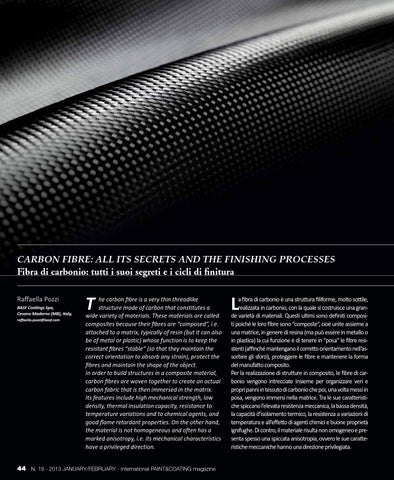CARBON FIBRE: ALL ITS SECRETS AND THE FINISHING PROCESSES Fibra di carbonio: tutti i suoi segreti e i cicli di finitura Raffaella Pozzi BASF Coatings Spa, Cesano Maderno (MB), Italy, raffaella.pozzi@basf.com
T
he carbon fibre is a very thin threadlike structure made of carbon that constitutes a wide variety of materials. These materials are called composites because their fibres are “composed”, i.e. attached to a matrix, typically of resin (but it can also be of metal or plastic) whose function is to keep the resistant fibres “stable” (so that they maintain the correct orientation to absorb any strain), protect the fibres and maintain the shape of the object. In order to build structures in a composite material, carbon fibres are woven together to create an actual carbon fabric that is then immersed in the matrix. Its features include high mechanical strength, low density, thermal insulation capacity, resistance to temperature variations and to chemical agents, and good flame retardant properties. On the other hand, the material is not homogeneous and often has a marked anisotropy, i.e. its mechanical characteristics have a privileged direction.
44 N. 19 - 2013 JANUARY/FEBRUARY - international PAINT&COATING magazine
L
a fibra di carbonio è una struttura filiforme, molto sottile, realizzata in carbonio, con la quale si costruisce una grande varietà di materiali. Questi ultimi sono definiti compositi poiché le loro fibre sono “composte”, cioè unite assieme a una matrice, in genere di resina (ma può essere in metallo o in plastica) la cui funzione è di tenere in “posa” le fibre resistenti (affinché mantengano il corretto orientamento nell’assorbire gli sforzi), proteggere le fibre e mantenere la forma del manufatto composito. Per la realizzazione di strutture in composito, le fibre di carbonio vengono intrecciate insieme per organizzare veri e propri panni in tessuto di carbonio che poi, una volta messi in posa, vengono immersi nella matrice. Tra le sue caratteristiche spiccano l’elevata resistenza meccanica, la bassa densità, la capacità d’isolamento termico, la resistenza a variazioni di temperatura e all’effetto di agenti chimici e buone proprietà ignifughe. Di contro, il materiale risulta non omogeneo e presenta spesso una spiccata anisotropia, ovvero le sue caratteristiche meccaniche hanno una direzione privilegiata.
